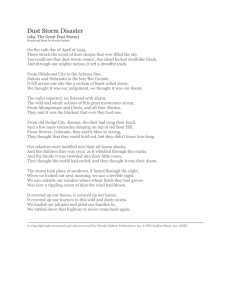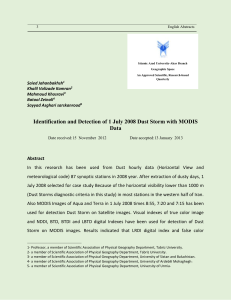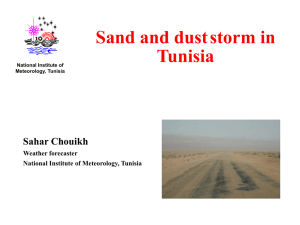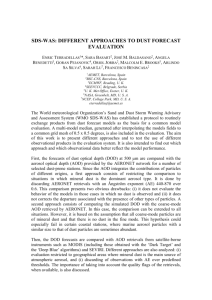Coordination of atmospheric sand and dust storm forecasting
advertisement
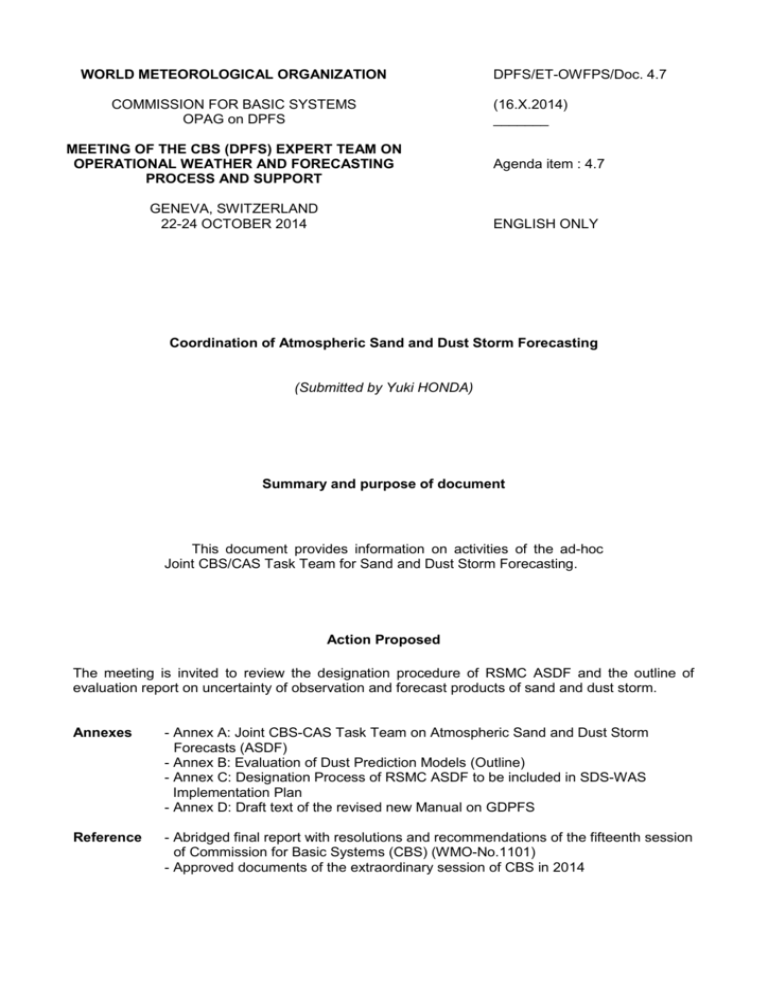
WORLD METEOROLOGICAL ORGANIZATION COMMISSION FOR BASIC SYSTEMS OPAG on DPFS MEETING OF THE CBS (DPFS) EXPERT TEAM ON OPERATIONAL WEATHER AND FORECASTING PROCESS AND SUPPORT GENEVA, SWITZERLAND 22-24 OCTOBER 2014 DPFS/ET-OWFPS/Doc. 4.7 (16.X.2014) _______ Agenda item : 4.7 ENGLISH ONLY Coordination of Atmospheric Sand and Dust Storm Forecasting (Submitted by Yuki HONDA) Summary and purpose of document This document provides information on activities of the ad-hoc Joint CBS/CAS Task Team for Sand and Dust Storm Forecasting. Action Proposed The meeting is invited to review the designation procedure of RSMC ASDF and the outline of evaluation report on uncertainty of observation and forecast products of sand and dust storm. Annexes - Annex A: Joint CBS-CAS Task Team on Atmospheric Sand and Dust Storm Forecasts (ASDF) - Annex B: Evaluation of Dust Prediction Models (Outline) - Annex C: Designation Process of RSMC ASDF to be included in SDS-WAS Implementation Plan - Annex D: Draft text of the revised new Manual on GDPFS Reference - Abridged final report with resolutions and recommendations of the fifteenth session of Commission for Basic Systems (CBS) (WMO-No.1101) - Approved documents of the extraordinary session of CBS in 2014 1. Reports of CBS 15th Session (2012) and CBS Extraordinary Session (2014) 1.1 A part relevant to the sand and dust storms forecasting is extracted below from the abridged final report of the 15th Session of the Commission for Basic Systems (CBS): 4.4.16 Noting the results of the work of the ad hoc joint CAS-CBS Task Team on Sand and Dust Storm Warning Assessment Systems (SDS-WAS), the Commission agreed that there is a need to incorporate the mandatory functions and criteria for the designation of RSMC with activity specialization in Atmospheric Sand and Dust storm Forecasts (RSMC-ASDF) in the current version of the Manual on the GDPFS, and therefore proposed an amendment to the Manual on the GDPFS, as found in Annex 1 to Recommendation 13 (CBS-15). The Commission was presented with the nomination of the centre in Barcelona (Spain) to act as an RSMC-ADSF for the Northern Africa (north of Equator), Middle East and Europe. Noting that this centre complies with the mandatory functions, the Commission recommended its formal designation, and therefore proposed an amendment to the Manual on the GDPFS, as found in Annex 1 to Recommendation 13 (BS-15). The Commission adopted Recommendation 13 (CBS-15) – Amendments to the Manual on the Global Data-processing and Forecasting System (WMO-No. 485). 4.4.17 The Commission noted that atmospheric sand and dust storm forecasts are of particular importance as dust storms strongly affect socio-economic sectors, including maritime and air transportation. However, the Commission expressed its concern regarding the uncertainty of the sand and dust storm model outputs and the consistency between these products and the observations. It therefore requested the OPAG on DPFS to work with the CAS Steering Groups on SDS-WAS in the assessment of the reliability/maturity of such products for operational purposes, as well as in further developing and utilizing widespread dust forecasting models. Until these matters are resolved, the Commission decided to include a statement concerning their reliability with these products. 4.4.18 Many Members have informed of their capabilities to produce and delivery atmospheric sand and dust storm forecasts, and expressed interest in cooperating with the centre in Barcelona on these issues, including on verification. 1.2 A part relevant to the sand and dust storms forecasting is extracted below from the approved documents of the Extraordinary Session of CBS in 2014: 2.2.6 The Commission noted that the Regional Association II (RA II) strongly encouraged China to realize its plans related to sand and dust storm-related services and recommended a demonstration of operational forecasting capabilities, to serve Members of the eastern part of RA II in dust monitoring and forecasting. The Commission acknowledged the efforts by SDSWAS Regional Node in Asia in the development of the Asian SDS-WAS portal, data exchange and data policy, and model intercomparison, and therefore requested China, in collaboration with the relevant SDS-WAS Regional Node in Asia, to prepare an assessment document to demonstrate its capabilities in operational sand and dust storm forecasting. The Commission also requested OPAG-DPFS, in collaboration with the SDS-WAS Steering Committee, to coordinate the assessment of the capabilities against the designation criteria stated in the Manual on the GDPFS (WMO-No. 485), prior to its formal recommendation for designation. The Commission agreed that the President of CBS would seek approval for designation by EC based on the positive result of the assessment. 2. Reestablishment of Joint CAS/CBS Task Team and its Activities 2.1 The ad-hoc Joint CAS/CBS Task Team on Atmospheric Sand and Dust Storm Forecasts (ASDF) was re-established to coordinate activities on RSMC ASDF for limited time from 2013 to 2014. The Team is tasked to address the two issues: designation criteria and process of RSMC ASDF and assessment of the reliability/maturity of sand and dust storms forecasting products. The full member list and terms of reference of the Team are shown in Annex A. 2.2 The CAS members of the Team is now developing a report Evaluation of Dust Prediction Models to assess the reliability/maturity of sand and dust storm model outputs for operational purpose. The outline of the report is shown in Annex B. 3. Designation Process of RSMC ASDF 3.1 The Team evaluated the criteria for designation and mandatory functions of RSMC ASDF and concluded that no amendment was needed. However, the Team recognized that model intercomparison in SDS-WAS regional node is essential to ensure quality of sand and dust storm forecast products for operational purpose and, therefore, the involvement of the CAS is clarified in the designation process. In this regard, the Team develops the draft text of such designation process shown in Annex C to be included in the SDS-WAS Implementation Plan. 3.2 It is requested to establish clear linkage between this document and the Manual on GDPFS and mechanism to keep them consist. 4. Revision of the Manual on GDPFS 4.1 It is planned to replace the current Manual on GDPFS (WMO-No.485) with the new version at the next regular session of CBS in 2016. The draft text of the new Manual is being developed and a whole set of the draft text as of June 2014 were submitted to the CBS-Ext.(2014) for reference. Its part relevant to RSMC ASDF is shown in Annex D. 4.2 Considering the restructuring of CAS, the draft text is slightly modified with track-change. 5. Future plan 5.1 Since the tasks are not completed yet, it is needed to extend the activities of the Team till 2016 when the CBS 16th Session is organized. Annex A Joint CBS-CAS Task Team on Atmospheric Sand and Dust Storm Forecasts (ASDF) Terms of Reference - Revise, as appropriate, the criteria for designation and mandatory functions of RSMC ASDF, for incorporation in the new Manual on the GDPFS - Review the CAS study on uncertainty of sand and dust storm observation and forecast products, evaluate whether it addresses the CBS-15 concerns, and address the identified gaps (if any) Members (CAS) (CBS) - Slobodan NICKOVIC (Chair of NA-ME-E node) Masao MIKAMI (Chair of Asian node) Emilio CUEVAS-AGULLO (AEMET) Yuki HONDA (Co-chair of OPAG-DPFS) Jianjie WANG (Co-chair of ET-OWFPS) José María BALDASANO (Representative of RSMC ASDF, BSC) Annex B Evaluation of Dust Prediction Models Outline 0. Abstract (0.5 pp) 1. Motivation (1 pp.) 2. Dust models. State of the art (5 pp.) (1) Dust prediction models (2) Global and regional models (3) Data assimilation (4) Ensemble prediction (5) Model evaluation 3. Observational data (5 pp.) (1) Dust observation (2) Air quality monitoring stations (3) Meteorological reports: visibility and present weather (4) Sun photometers (5) Lidar and ceilometer (6) Satellite products 4. Evaluation metrics (2 pp.) (1) Definition (2) Performance of the different statistics 5. Evaluation of dust prediction models at WMO SDS-WAS Regional centers (5pp each) (1) Regional Center for Northern Africa, Middle East and Europe (2) Regional Center for Asia (3) Regional Center for the Americas 6. Other evaluation initiatives (2 pp. each) (1) MACC (2) AEROCOM (3) ICAP (4) Others… 7. Conclusions and future work (3 pp.) 8. References Annex C Designation Process of RSMC ASDF to be included in SDS-WAS Implementation Plan 7. Transition to operational activities: Proposed designation as Regional Specialized Meteorological Center with specialization on Atmospheric Sand and Dust Forecasting (RSMC-ASDF) Those institutions / nodes has reached a high level of maturity in dust forecasting and are interested and commit to initiate operational dust predictions in the context of the WMO Global Data-Processing and Forecasting System (GDPFS) and Regional Specialized Meteorological Centre (RSMC) structures, should follow this procedure: step 1. The institution concerned must present a technical report to the SDS-WAS Regional Committee (RC) demonstrating the quality of dust forecasts for operational use in the region following criteria and recommendations documented in the GDPFS Manual (WMO-No. 485). Model evaluation and intercomparison studies should be described in detail. The proposal should be approved by the SDS-WAS RC. step 2. SDS-WAS Steering Committee (SC) should approve the proposal submitted by SDS-WAS RC. step 3. World Weather Research Programme - Scientific Steering Committee – (WWRP SSC) should approve the proposal submitted by the SDS-WAS SC. step 4. Chair of WWRP SSC should recommend the proposal to the Commission of Atmospheric Science (CAS) President. step 5. CAS President should recommend the proposal to the Commission for Basic Systems (CBS) President. Annex D Draft text of the revised new Manual on GDPFS 2.2.10. Atmospheric Sand and Dust Storm Forecasts Centres participating in activity II.2.2.10, atmospheric sand and dust storm forecasts, shall: - Operate a numerical weather prediction model incorporating parameterizations of all the major phases of the atmospheric dust cycle - Prepare limited area analyses of variables relevant to atmospheric sand and dust storms - Prepare limited area forecast fields of variables relevant to atmospheric sand and dust storms - Make available on the WIS and on a web portal a range of these products. The minimum list to be made available is given in Appendix A.II.2.2.10-a RESPONSIBILITY To be proposed by: To be approved by: To be decided by: To be approved by: To be decided by: To be monitored by: To be reported to: CHANGES TO ACTIVITY SPECIFICATION CAS/Steering Group CBS/ET-ERA of SDS-WAS CAS (WWRP/JSSC) CBS EC / Congress CENTRES DESIGNATION CAS (WWRP/JSSC) CBS EC / Congress COMPLIANCE CBS/ET-ERA CBS/ICT-DPFS CBS Appendix A.II.2.2.10-a MINIMUM LIST OF ATMOSPHERIC SAND AND DUST STORM PRODUCTS TO BE MADE AVAILABLE ON THE WIS Forecasts, with an appropriate uncertainty information statement, of the following set of variables: - Dust load (kg•m–2) - Dust concentration at the surface (μg•m–3) - Dust optical depth at 550 nm (–) - 3-hour accumulated dry and wet deposition (kg•m–2) Forecasts shall cover the period from the starting forecast time (00 and/or 12 UTC) up to a forecast time of at least 72 hours, with an output frequency of at least 3 hours. They shall cover the whole designated area. The horizontal resolution shall be finer than 0.5x0.5 degrees. Forecasts shall be disseminated through the WIS in digital form and provided on a Web portal in pictorial form not later than 12 hours after the starting forecast time. An explanatory note should be published on the Web portal when operations are stopped due to technical problems.

